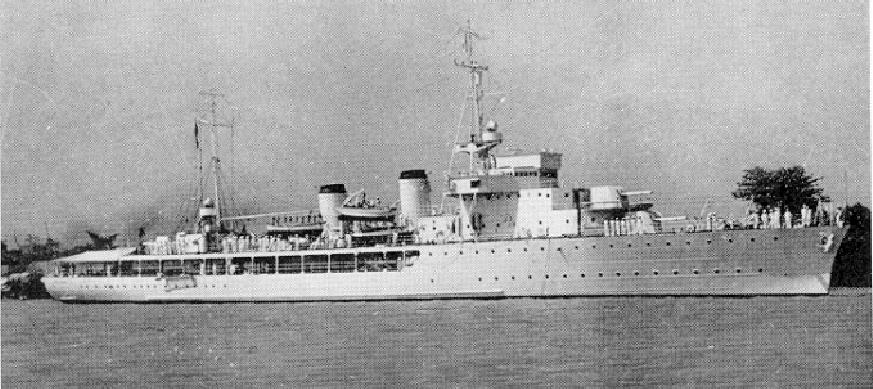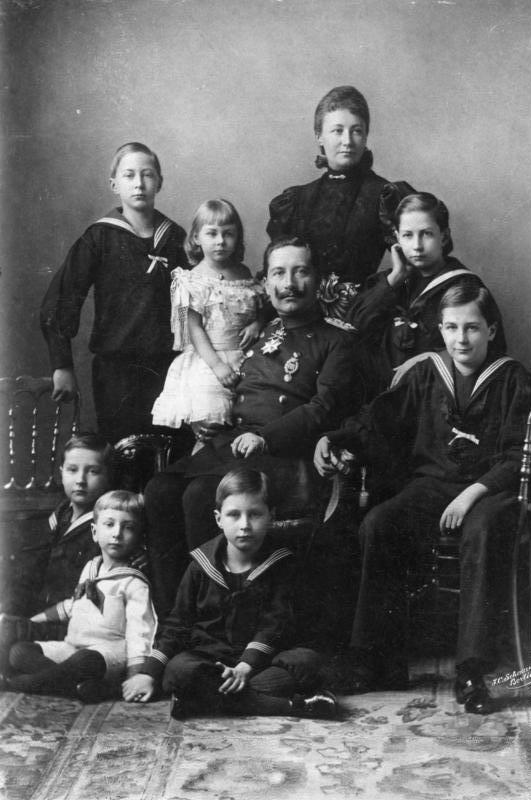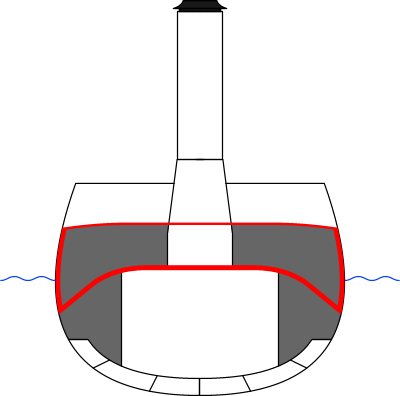|
SMS Leipzig (1905)
SMS ("His Majesty's Ship ") was the sixth of seven s of the Imperial German Navy, named after the city of Leipzig. She was begun by AG Weser in Bremen in 1904, launched in March 1905 and commissioned in April 1906. Armed with a main battery of ten guns and two torpedo tubes, was capable of a top speed of . spent her career on overseas stations; at the outbreak of World War I in August 1914, she was cruising off the coast of Mexico. After rejoining with the East Asia Squadron, she proceeded to South American waters, where she participated in the Battle of Coronel, where the German squadron overpowered and sank a pair of British armored cruisers. A month later, she again saw action at the Battle of the Falkland Islands, which saw the destruction of the East Asia Squadron. was chased down and sunk by the cruisers and ; the majority of her crew was killed in the battle, with only 18 survivors. Design The German German Naval Laws, 1898 Naval Law called for the replacement ... [...More Info...] [...Related Items...] OR: [Wikipedia] [Google] [Baidu] |
German Empire
The German Empire (),Herbert Tuttle wrote in September 1881 that the term "Reich" does not literally connote an empire as has been commonly assumed by English-speaking people. The term literally denotes an empire – particularly a hereditary empire led by an emperor, although has been used in German to denote the Roman Empire because it had a weak hereditary tradition. In the case of the German Empire, the official name was , which is properly translated as "German Empire" because the official position of head of state in the constitution of the German Empire was officially a "presidency" of a confederation of German states led by the King of Prussia who would assume "the title of German Emperor" as referring to the German people, but was not emperor of Germany as in an emperor of a state. –The German Empire" ''Harper's New Monthly Magazine''. vol. 63, issue 376, pp. 591–603; here p. 593. also referred to as Imperial Germany, the Second Reich, as well as simply Germany, ... [...More Info...] [...Related Items...] OR: [Wikipedia] [Google] [Baidu] |
Imperial German Navy
The Imperial German Navy or the Imperial Navy () was the navy of the German Empire, which existed between 1871 and 1919. It grew out of the small Prussian Navy (from 1867 the North German Federal Navy), which was mainly for coast defence. Wilhelm II, German Emperor, Kaiser Wilhelm II greatly expanded the navy. The key leader was Admiral Alfred von Tirpitz, who greatly expanded the size and quality of the navy, while adopting the sea power theories of American strategist Alfred Thayer Mahan. The result was a Anglo-German naval arms race, naval arms race with Britain, as the German navy grew to become one of the greatest maritime forces in the world, second only to the Royal Navy. The German surface navy proved ineffective during the First World War; its only major engagement, the Battle of Jutland, was a draw, but it kept the surface fleet largely in port for the rest of the war. The submarine fleet was greatly expanded and threatened the British supply system during the Atlantic ... [...More Info...] [...Related Items...] OR: [Wikipedia] [Google] [Baidu] |
Beam (nautical)
The beam of a ship is its width at its widest point. The maximum beam (BMAX) is the distance between planes passing through the outer extremities of the ship, beam of the hull (BH) only includes permanently fixed parts of the hull, and beam at waterline (BWL) is the maximum width where the hull intersects the surface of the water. Generally speaking, the wider the beam of a ship (or boat), the more initial stability it has, at the expense of secondary stability in the event of a capsize, where more energy is required to right the vessel from its inverted position. A ship that heels on her ''beam ends'' has her deck beams nearly vertical. Typical values Typical length-to-beam ratios ( aspect ratios) for small sailboats are from 2:1 (dinghies to trailerable sailboats around ) to 5:1 (racing sailboats over ). Large ships have widely varying beam ratios, some as large as 20:1. Rowing shells designed for flatwater racing may have length to beam ratios as high as 30:1, while a cor ... [...More Info...] [...Related Items...] OR: [Wikipedia] [Google] [Baidu] |
Length Overall
__NOTOC__ Length overall (LOA, o/a, o.a. or oa) is the maximum length of a vessel's hull measured parallel to the waterline. This length is important while docking the ship. It is the most commonly used way of expressing the size of a ship, and is also used for calculating the cost of a marina berth (for example, £2.50 per metre LOA). LOA is usually measured on the hull alone. For sailing ships, this may ''exclude'' the bowsprit and other fittings added to the hull. This is how some racing boats and tall ships use the term LOA. However, other sources may include bowsprits in LOA. Confusingly, LOA has different meanings. "Sparred length", "Total length including bowsprit", "Mooring length" and "LOA including bowsprit" are other expressions that might indicate the full length of a sailing ship. LOD Often used to distinguish between the length of a vessel including projections (e.g. bow sprits, etc.) from the length of the hull itself, the Length on Deck or LOD is often repor ... [...More Info...] [...Related Items...] OR: [Wikipedia] [Google] [Baidu] |
Hull (watercraft)
A hull is the watertight body of a ship, boat, or flying boat. The hull may open at the top (such as a dinghy), or it may be fully or partially covered with a deck. Atop the deck may be a deckhouse and other superstructures, such as a funnel, derrick, or mast. The line where the hull meets the water surface is called the waterline. General features There is a wide variety of hull types that are chosen for suitability for different usages, the hull shape being dependent upon the needs of the design. Shapes range from a nearly perfect box in the case of scow barges to a needle-sharp surface of revolution in the case of a racing multihull sailboat. The shape is chosen to strike a balance between cost, hydrostatic considerations (accommodation, load carrying, and stability), hydrodynamics (speed, power requirements, and motion and behavior in a seaway) and special considerations for the ship's role, such as the rounded bow of an icebreaker or the flat bottom of a landing craft. ... [...More Info...] [...Related Items...] OR: [Wikipedia] [Google] [Baidu] |
German Colonial Empire
The German colonial empire (german: Deutsches Kolonialreich) constituted the overseas colonies, dependencies and territories of the German Empire. Unified in the early 1870s, the chancellor of this time period was Otto von Bismarck. Short-lived attempts at colonization by individual German states had occurred in preceding centuries, but Bismarck resisted pressure to construct a colonial empire until the Scramble for Africa in 1884. Claiming much of the left-over uncolonized areas of Africa, Germany built the third-largest colonial empire at the time, after the British and French. The German Colonial Empire encompassed parts of several African countries, including parts of present-day Burundi, Rwanda, Tanzania, Namibia, Cameroon, Gabon, Congo, Central African Republic, Chad, Nigeria, Togo, Ghana, as well as northeastern New Guinea, Samoa and numerous Micronesian islands. Including mainland Germany, the empire had a total land area of 3,503,352 square kilometers and pop ... [...More Info...] [...Related Items...] OR: [Wikipedia] [Google] [Baidu] |
Aviso
An ''aviso'' was originally a kind of dispatch boat or "advice boat", carrying orders before the development of effective remote communication. The term, derived from the Portuguese and Spanish word for "advice", "notice" or "warning", an ''aviso'', was later adopted by the French and Portuguese navies to classify their medium-sized warships designed for colonial service. The term continued to be used in the French Navy to classify the patrol frigates until 2012, when the remaining ships of the class were reclassified as offshore patrol ships. It is equivalent to the modern use of "sloop" in other countries. Description The ''Dictionnaire de la Marine Française 1788–1792'' (by Nicolas-Charles Romme) describes ''avisos'' as "small boats designed to carry orders or dispatches". This use became obsolete with the development of means of communicating detailed information at a distance. French ''avisos'' used during World War I and World War II had displacements of 300–7 ... [...More Info...] [...Related Items...] OR: [Wikipedia] [Google] [Baidu] |
Unprotected Cruiser
An unprotected cruiser was a type of naval warship in use during the early 1870s Victorian or pre-dreadnought era (about 1880 to 1905). The name was meant to distinguish these ships from “protected cruisers”, which had become accepted in the 1880s. A protected cruiser did not have side armor on its hull like a battleship or “armored cruiser” but had only a curved armored deck built inside the ship — like an internal turtle shell — which prevented enemy fire penetrating through the ship down into the most critical areas such as machinery, boilers, and ammunition storage. An unprotected cruiser lacked even this level of internal protection. The definitions had some gray areas, because individual ships could be built with a protective deck that did not cover more than a small area of the ship, or was so thin as to be of little value. The same was true of the side armor on some armored cruisers. An unprotected cruiser was generally cheaper and less effective t ... [...More Info...] [...Related Items...] OR: [Wikipedia] [Google] [Baidu] |
Steam Corvette
Steam frigates (including screw frigates) and the smaller steam corvettes, steam sloops, steam gunboats and steam schooners, were steam-powered warships that were not meant to stand in the line of battle. There were some exceptions like for example the French Napoléon class steam ship of the line was meant to stand in the line of battle, making it the world's first steam battleship. The first such ships were paddle steamers. Later on the invention of screw propulsion enabled construction of steam-powered versions of the traditional ships of the line, frigates, corvettes, sloops and gunboats. Evolution First steam warships The first small vessel that can be considered a steam warship was the ''Demologos'', which was launched in 1815 for the United States Navy. From the early 1820s, the British Navy began building a number of small steam warships including the armed tugs and , and by the 1830s the navies of America, Russia and France were experimenting with steam-powered ... [...More Info...] [...Related Items...] OR: [Wikipedia] [Google] [Baidu] |
German Naval Laws
The Naval Laws (german: Flottengesetze, "Fleet Laws") were five separate laws passed by the German Empire, in 1898, 1900, 1906, 1908, and 1912. These acts, championed by Kaiser Wilhelm II and his Secretary of State for the Navy, Grand Admiral Alfred von Tirpitz, committed Germany to building up a navy capable of competing with the Royal Navy of the United Kingdom. German desires and the strategic debate The Kaiser had long wanted a large naval force to assure Germany of what he called " a place in the sun". A large German navy could assist in German attempts to attain colonies, as well as further the country's economic and commercial interests elsewhere in the world. He was determined to make his country a colonial power in Africa and the Pacific. He was also a very militaristic man, and wished to increase the strength of the German armed forces; in particular he wanted to develop a navy that could match the British Royal Navy. As he wrote in his autobiography: Though Wilhel ... [...More Info...] [...Related Items...] OR: [Wikipedia] [Google] [Baidu] |
Armored Cruiser
The armored cruiser was a type of warship of the late 19th and early 20th centuries. It was designed like other types of cruisers to operate as a long-range, independent warship, capable of defeating any ship apart from a battleship and fast enough to outrun any battleship it encountered. For many decades, naval technology had not advanced far enough for designers to produce a cruiser which combined an armored belt with the long range and high speed required to fulfill its mission. For this reason, beginning in the 1880s and 1890s, many navies preferred to build protected cruisers, which only relied on a light armored deck to protect the vital parts of the ship. However, by the late 1880s, the development of modern rapid-fire breech-loading cannon and high-explosive shells made the reintroduction of side armor a necessity. The invention of face-hardened armor in the mid-1890s offered effective protection with less weight than previously. Varying in size, the armored cruiser was ... [...More Info...] [...Related Items...] OR: [Wikipedia] [Google] [Baidu] |






